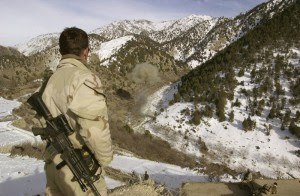Praxis: Small Unit Logisitics Link
Putting all your eggs in a nice big basket. "During a search-and-destroy mission, U.S. Navy SEALs discover a large cache of munitions in one of more than 50 caves explored in the Zhawar Kili area. Used by al Qaeda and Taliban forces, the caves and above-ground complexes were subsequently destroyed through air strikes called in by the SEALs. Navy special operations forces were conducting missions in Afghanistan in support of Operation Enduring Freedom. U.S. Navy photo."
Politics being what they are these days, it strikes me that now is the time to repost this link on small unit logistics from 2008. And remember, if you're going to cache, don't make the mistake these mokes did.
Arguably the most significant, certainly the most spectacular, mission conducted by Task Force K-Bar occurred in January 2002 in a narrow canyon in Paktika province in eastern Afghanistan, about 16 kilometers southwest of Khost and four kilometers from the Pakistani border. The place was called Zhawar Kili.
Created by the mujahideen guerrillas fighting the Soviet Army during the Soviet-Afghanistan War (1978-92), Zhawar Kili was initially used as a training base. Because of its strategic location close to the Pakistani border, it soon expanded into a major base for supplies and combat operation planning as well. At its height during that war, it contained at least 11 major tunnels, some extending as far as 500 meters into the mountain, and facilities included a hotel, a mosque, arms depots, repair shops, a garage, a small hospital, a communications center, and a kitchen. Following the rise of the Taliban, intelligence determined that the canyon had subsequently become an al Qaeda base of operations. In 1998, U.S. cruise missiles had been launched against the complex in response to al Qaeda’s bombings of U.S. embassies in Kenya and Tanzania. Though intelligence had determined that there were multiple targets of interest in Zhawar Kili, the extent of al Qaeda’s use of the canyon was unknown.
What happened to these huge caches stacked up, more or less conveniently, in one place? Why Navy SEALS found them and blew them up.
"A Navy SEAL observes munitions being destroyed. The SEALs discovered the munitions while conducting a Sensitive Site Exploitation (SSE) mission in Eastern Afghanistan. U.S. Navy photo by Photographer's Mate 1st Class Tim Turner"


3 comments:
I saw a similar complex in the Que Son mountains of Viet-Nam. Marine Recon troops had discovered it and Marine HQ was trying to come up with a plan to destroy it on the cheap. Someone came up with a plan to fill 55 gallon drums with JP-4, FELLS Naptha soap and toilet paper, effectively making napalm. Hundreds of drums were placed on Marble Mountain runway and filled with the solution, then place in heavy duty cargo nets, which were externally lifted by helicopters over the drop zone. As the loads were pickled, door gunners fired 50 caliber tracer rounds into the drums, igniting them. The massive operation ran for hours and destroyed the complex; killing as I remember, 200 enemy. Total positive effect on the war effort in Quang Nam province? Zero!
Never put all your eggs in one basket.
The trouble is, it always seems easier to keep it in one place. Easier to accept, store, keep track of, and issue. But when the enemy locates it, you lose the whole thing.
Post a Comment